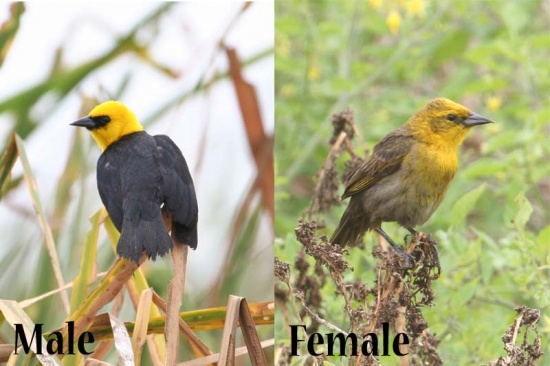- Chrysomus icterocephalus
Identification
21-26 cm (8¼-10¼ in
Male
- Black body
- Yellow hood and upper chest
- Black lores
- Black bill
Female
- Greyish-olive upperparts
- Brown belly flecked with black
- Dusky-yellow hood
- Yellow throat and the stripe over the eye is brighter
Juveniles are similar to females, but duller, with less yellow on head, paler upperparts and buffish underparts obscurely streaked.
Immatures are also like females but brighter, more extensive yellow on throat and they may show black feathers in underparts and upperparts.
Variations
Female bogotensis is darker, with less yellowish head, dusky olive or blackish mask over lores to ear-coverts strongly contrasting with long, narrow superciliary skirting ear-coverts and meeting a well-defined yellow bib
Distribution
South America: found from Colombia and Peru to Brazil, the Guianas, and Trinidad. Fairly common to locally common. bogotensis has a very small range. Introduced population persists around Lima, Peru.
Taxonomy
This species has previously been thought to belong to the genus Agelaius.
Subspecies
There are 2 subspecies[1]:
- C. i. bogotensis:
- Eastern Colombia (Bogotá Plateau)
- C. i. icterocephalus:
Habitat
Marshes and wet grasslands, along Amazon River and tributaries mostly in várzea grassland. Also in humid savannas, mangroves and abandoned rice fields. Forages often in ploughed fields. Occurs from lowlands up to 1000 m, bogotensis up to 2600 m.
Behaviour
This species likes to flock, sometimes associating with other species of Icterids.
Breeding
Breeding season July to October in Venezuela, May to November in Trinidad, March to September in Suriname and March to May in central Colombia (bogotensis). The male builds a nest in aquatic vegetation, then uses a fluttering flight display to attract a female. If accepted the female adds more lining material to the nest. The male stays with her until she begins incubating the 2 or 3 eggs. He may mate with up to 5 females in the season; additional nests are within his territory. Occasionally, congregations of several males nesting next to each other and each with several females associated can lead to large colonies. About 30 to 40% of the nests are parasitized by Shiny Cowbird. Incubation takes around 10-11 days, with the young fledging after about 11 days.
Diet
The diet includes aquatic insects, grain, and weed seeds.
Movements
Largely resident. Local movements in areas with well defined dry seasons.
Vocalisation
Two song types, one with brief notes or whistles followed by harsh buzz, the other a variable and nice sequence of warbles or whistles. The two songs may be alternated. The song structure is similar to those of Chestnut-capped Blackbird, but it's less musical and harsher. Often sings in groups. The call is a chek or a descending whistle.
References
- Clements, J. F., T. S. Schulenberg, M. J. Iliff, D. Roberson, T. A. Fredericks, B. L. Sullivan, and C. L. Wood. 2018. The eBird/Clements checklist of birds of the world: v2018. Downloaded from http://www.birds.cornell.edu/clementschecklist/download/
- Del Hoyo, J, A Elliott, and D Christie, eds. 2011. Handbook of the Birds of the World. Volume 16: Tanagers to New World Blackbirds. Barcelona: Lynx Edicions. ISBN 978-8496553781
- Planet of Birds
- Fraga, R. (2019). Yellow-hooded Blackbird (Chrysomus icterocephalus). In: del Hoyo, J., Elliott, A., Sargatal, J., Christie, D.A. & de Juana, E. (eds.). Handbook of the Birds of the World Alive. Lynx Edicions, Barcelona. (retrieved from https://www.hbw.com/node/62314 on 30 June 2019).
- Yellow-hooded Blackbird (Chrysomus icterocephalus), In Neotropical Birds Online (T. S. Schulenberg, Editor). Cornell Lab of Ornithology, Ithaca, NY, USA. retrieved from Neotropical Birds Online: https://neotropical.birds.cornell.edu/Species-Account/nb/species/yehbla2
Recommended Citation
- BirdForum Opus contributors. (2025) Yellow-hooded Blackbird. In: BirdForum, the forum for wild birds and birding. Retrieved 30 April 2025 from https://www.birdforum.net/opus/Yellow-hooded_Blackbird
External Links
GSearch checked for 2020 platform.1





